A box that enlarges your head; a mechanical tail you can attach to your own body; cardboard figures based on Google Street View shots; and a computer game in which you can play as really anything—in this series of temporary exhibitions and round-table discussions staged in Japan’s ultra-urban Tokyo Midtown complex, art, technology and social critique converge. What does it mean to shift perspectives? How do we deal with modern information overload? And how do technology and society influence each other reciprocally?
In this series of exhibitions and Talk Sessions staged at regular intervals since 2017, the Ars Electronica Futurelab and Tokyo Midtown have been collaborating with people in Tokyo to find out what potential answers to these questions might be like. In this interview, Kyoko Kunoh and Hideaki Ogawa, artists/researchers at the Ars Electronica Futurelab, talk about why the School of the Future was launched, what activities have already taken place, and why discussions about socially relevant topics shouldn’t be held in isolated, discrete spaces.
Let’s start with the basics. What is the School of the Future?
Kyoko Kunoh: The School of the Future is a program by Ars Electronica and Tokyo Midtown which we started last year, in 2017. It is an exhibition and talk session event. The theme of our School of the Future is that people can learn about new trends in our society that they cannot learn in schools. It is made for people of all ages, depending on the exhibition. The first time when we hosted School of the Future, in summer 2017, we planned an exhibition called “What IF?” for children younger than 10 years. The second exhibition, “Out of Control”, was aimed more at adults, professional designers, or people generally interested in design, art, and society.
How was the idea for School of the Future developed?
Hideaki Ogawa: Tokyo Midtown itself is a kind of urban complex, consisting of a shopping mall, hotel, office buildings, residential housing, hospital, museums and park etc. all together in one environment. It is like a little city in the middle of Tokyo! It is one of the most famous urban development projects, with really nice open and cultural spaces. They celebrated their 10th anniversary last year, and of course they wanted to enhance the meaning of their town management. We encountered each other, Tokyo Midtown had already heard of us, and we personally had also heard about this really famous development project. So we discussed what the next, sustainable step in the process of creating this little city of Tokyo Midtown could be. We wanted to create a very creative platform for different people, especially for innovation. This is how this project started.
Based on this environment, we had the discussion on how to create a kind of school, where people can encounter future moments and also discussions about the future. Regularly, we had meetings with Tokyo Midtown to decide what kind of topics could be relevant for people who are living in or utilizing Tokyo Midtown. This is the reason why we are changing the topic and the target group for every edition, because the city is full of different types of people. Then, we started with the process of curating, depending on the timing and the topic of course. Our goal is to create a real School of the Future, but also in a way a Textbook of the Future.

Credit: Tokyo Midtown
There have already been two editions of School of the Future. What was the first one all about?
Kyoko Kunoh: The first exhibition was called “What IF?”, and it was about changing the perspective of visitors. At that time, we invited three artists to participate. The first one was David O’Reilly, who won last year’s Golden Nica at Prix Ars Electronica in the category of Computer Animation. His work is called “Everything”. It is a video game, which allows players to change their point of view into everything they see, from flowers, creatures, or big-scale things like planets to very small-scale things like atoms or insects. The second artist we presented was Ryota Kuwakubo, who has already shown his work at the Ars Electronica Festival several times, as well as at the Ars Electronica Center. The title of the work we presented at Tokyo Midtown is “SiliFulin” – it is a moving tail that you can attach to your body. By changing own body, you can feel like an animal. It is a project that audiences can actually experience how our tails change our behavior and communication. The last project was Big Face by Daily Portal Z and Techno-Shugei Club – it is a big box in which you can put your head in. The front of the box is a lens. It’s really very simple, but if people put their head in the box, the faces of the people appear to be really big. It is another way to show, in a simple way, how to change your point of view.
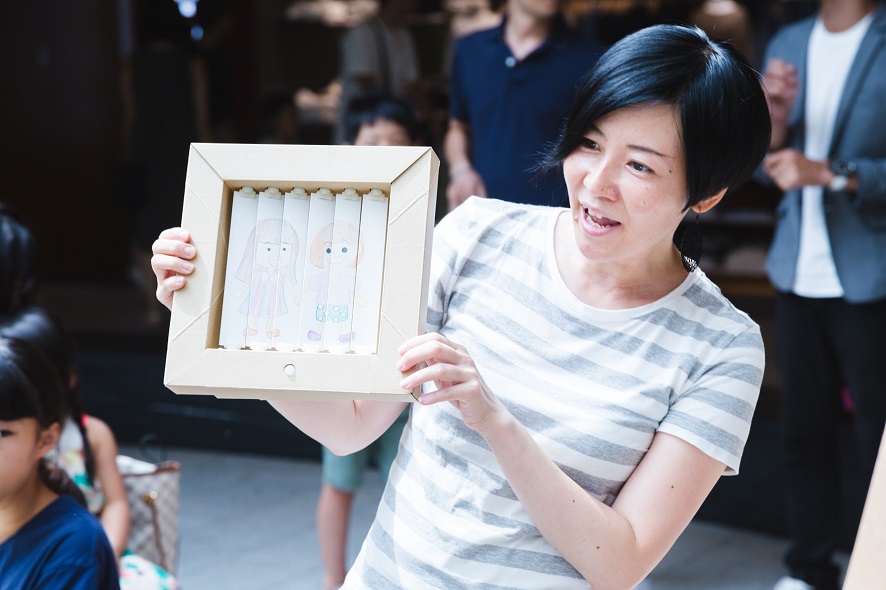
Credit: Tokyo Midtown
Hideaki Ogawa: We also showed an original development of the Ars Electronica Futurelab, “SWITCH”. It is a collaboration with ELEKIT, and we delivered a SWITCH workshop to the audience. The idea is that people can use the SWITCH to construct their own “What IF?”, for individuals. As an environment, they are experiencing projects like “SWITCH”, “Everything”, “SiliFulin”, “Big Face” and artistic inspiration to help kids find their own “What IF?”.
Kyoko Kunoh: We held the “SWITCH”-workshop every day for the children. In total, for this edition of School of the Future, we had over 2000 visitors over three days. We used a very open place, between a subway station and the heart of Tokyo Midtown. It is kind of semi-public, there are many people coming and going, so many people stopped by the exhibition.
The second installment was called “Out of Control”…
Kyoko Kunoh: We had already used this title as a festival theme in 1991, and there is also a permanent exhibit on this topic in the Ars Electronica Center. For the exhibition at Tokyo Midtown, we focused on projects dealing with the information society. The first artist we presented was Paolo Cirio, who has won several awards at the Prix Ars Electronica. This time, we showed his work “Street Ghosts”. He uses Google Street View and the people who have been captured in it with blurry faces. He makes life-sized prints of these people and puts them in the same place on the streets where their images had been captured. For Tokyo Midtown, we used Google Street View images from inside the building. He put around eight people’s prints inside an open area of Tokyo Midtown. Once he had put the printed cut-outs there, something very interesting happened – two of the people who had been captured by Google Street View came to the exhibition and saw themselves! One of them even took a photo of themselves with the print.
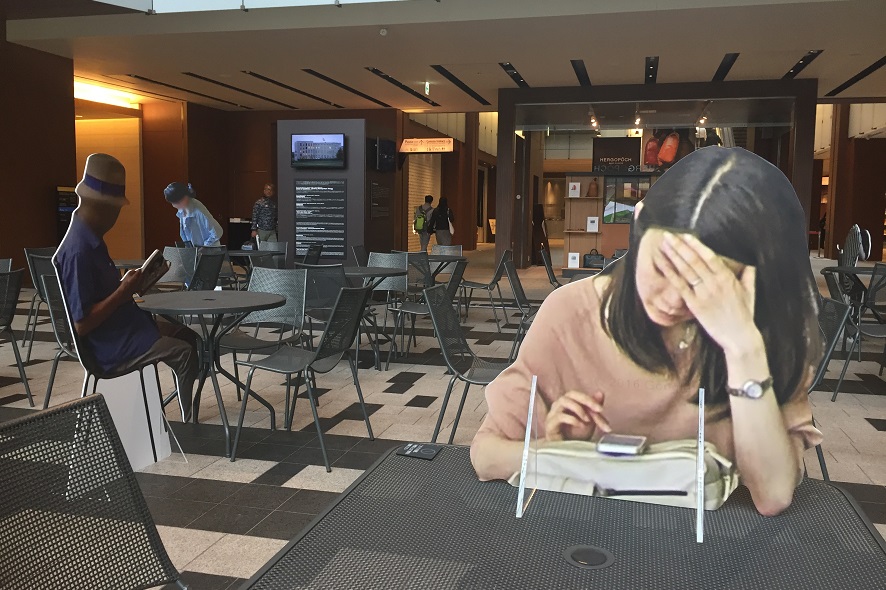
Credit: Tokyo Midtown
What about the other projects in the second exhibition?
Kyoko Kunoh: Takahiro Yamaguchi and So Kanno, two Japanese artists, showed their work “Asemic Languages”. They presented it already at last year’s festival at POSTCITY in Linz, in 2017.
Hideaki Ogawa: It is a project that presents non-readable text created by a machine-learning system. What is the meaning of language in our Social Media age? There is lots of information coming at us every day, and we are constantly receiving input, but the actual meaning is gone. The meaning of the language or the sentence is now shifting to something different. In the age of Social Media, we have situations which are “Out of Control”. There are governments, for instance, without naming names, which say something is fake, while other people claim that it’s actually the government which is fake. We don’t know which is the fake anymore! Not only authorities, but also normal people need to digest this. This is the reason why we curated this piece, to raise a question about the meaning of language and the responsibility to accept this much text or information into our lives, as our own person, not just a part of a swarm. I think in this sense, the project by Paolo Cirio is asking questions about privacy and ownership in the age of the information society. Another question by Takahiro Yamaguchi and So Kanno is the one about literacy – how can people have enough literacy to understand the many texts floating around in our daily lives? Ars Elelctronica members facilitated a discussion with people who are frequenting Tokyo Midtown about these topics as well, where the artists joined as well as the Tokyo Midtown manager. It was like a town meeting!
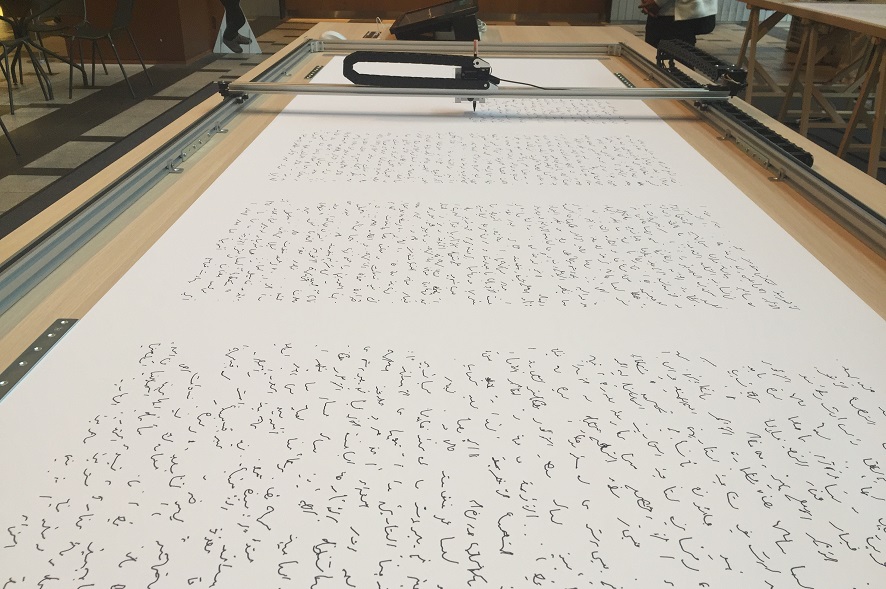
Credit: Tokyo Midtown
How were the reactions of visitors to the two exhibitions?
Kyoko Kunoh: I think there were a lot of reactions to both of the exhibitions. I was a little bit surprised, especially about the second edition. Of course, there are many Japanese people around who are interested in art, but usually not so many questions come from the audience. Yet, at Tokyo Midtown, there were many people who didn’t just come to see the exhibition, but they had so many questions for the artists and exhibition managers! It was very attractive for the audience, I think.

Credit: Tokyo Midtown
Why do you think it is necessary to discuss these topics outside of a traditional school? How is the School of the Future different?
Kyoko Kunoh: I am not sure about the schools in Europe, but in Japan, it is normal for the teacher to talk to the students, very one-sidedly. There are not so many discussions between the teacher and the students. This situation is changing a little bit now, but still, the basic principle remains. The teacher teaches the students. With this type of events or programs, we make place for a discussion for everybody. People can discuss these topics with each other, which is very important. We can provide this kind of platform with the artists and the people at Tokyo Midtown.
Hideaki Ogawa: I also think that nowadays, technology is advancing so fast, and this is not happening in closed-off spaces like laboratories anymore. These changes are happening all around us. So the setting at Tokyo Midtown is perfect, because a city always means a society. By doing this as a pop-up to raise certain questions right in the middle of this little town, this discussion is not happening in a white cube or a limited environment like a museum, school or box, but right in the middle of the people. This is the intention of the School of the Future. We are utilizing Tokyo Midtown as a model city to open the environment as a learning space to talk about these new realities and social issues, so people can take their own positions.
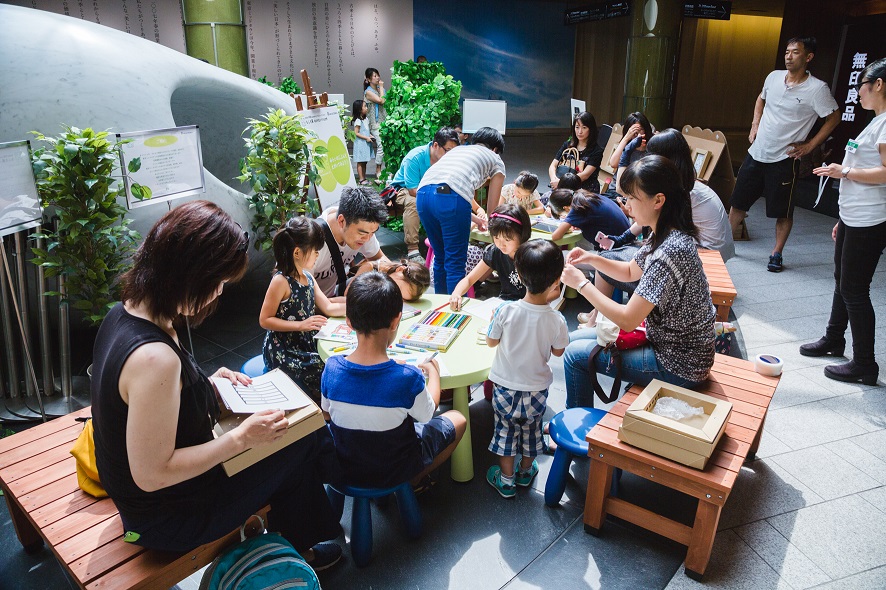
Credit: Tokyo Midtown
So what’s in store next for School of the Future?
Kyoko Kunoh: This year, in 2018, we are planning a small exhibition with a talking session about the topic of work. There are so many offices inside Tokyo Midtown, and they will also open their co-working spaces in April 2018. We plan to use these spaces. The Japanese public year also starts in April, so many fresh workers start their jobs around that time, so it is good timing to talk about this topic then. What is future work? What role does artificial intelligence and other technologies play in terms of work and in relation to human labor from now on? We want to start these kind of discussions.

Kyoko Kunoh is an artist and a researcher of Ars Electronica Futurelab. She has created extensively on art works in the interactive art field, and has been active in a wide range of fields such as directing in the public and commercial space, design of exhibit products, and joint project with companies and universities. Her projects have been featured in many different locations both domestically and internationally including Ars Electronica (Austria), SIGGRAPH (USA), Centre Pompidou (France) and Japan Media Arts Festival (Japan).
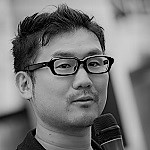
Hideaki Ogawa, Creative Catalyst, Artist, Curator and Key Researcher at Ars Electronica Futurelab. He has realized many projects for innovation with industries such as Honda R&D, Toshiba, Toyota and Hakuhodo etc. Specially, his focus is about Art Thinking to catalyze innovation. His leading project, Future Catalysts, is a creative and innovation base jointly-developed by Hakuhodo and Ars Electronica. Through “synergy” with distinctive worldwide innovators in the fields of art, science, and technology, the project produces new concepts, ideas, and strategies that serve as answers to various “creative questions”. In addition to the artistic innovation research, Hideaki Ogawa has realized international projects for festivals, export programs like Ars Electronica in the Knowledge Capital and the Ars Electronica Center. His special theme is about “Creative Catalyst” and “Robotinitiy – what is the nature of being a robot”. Hideaki Ogawa is also a representative and artistic director of the media artist group “h.o.”. He searches for witty new ideas depending on current social contexts, and is realizing artistic expressions with the speed of technological progress.
To learn more about Ars Electronica, follow us on Facebook, Twitter, Instagram et al., subscribe to our newsletter, and check us out online at https://ars.electronica.art/news/en/.
